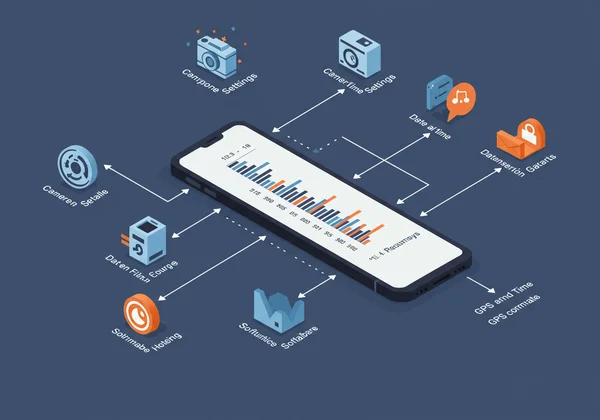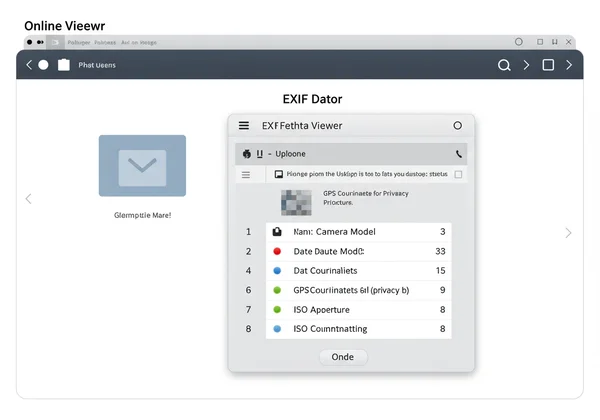Photo Privacy Checklist: Remove EXIF Data Before Sharing
Every time you share a photo, you might be revealing more than just a memory. Hidden within your images is a trail of data that can expose personal details. Are you unknowingly sharing your location or other private data every time you post a photo? This guide walks you through how to understand, check, and remove EXIF data so you can share photos safely and confidently. Get started and [check your photos] now.
Understanding EXIF Data & Your Photo Privacy Risks
To protect your privacy, you first need to know what you're up against. Most digital cameras and smartphones automatically embed information into every picture you take. This metadata is stored in the Exchangeable Image File Format (EXIF). While useful for organizing photos, it becomes a significant privacy risk when shared publicly.
What Information Does EXIF Data Contain?
EXIF data contains a surprising amount of detail beyond the visual content. This hidden information typically includes:
- Camera & Phone Details: The make and model of the device used (e.g., Apple iPhone 14 Pro, Canon EOS R5).
- Camera Settings: Technical details valuable to photographers, such as ISO speed, aperture, shutter speed, and focal length. For an in-depth guide on these settings, you can refer to The Exposure Triangle Explained by Nikon.
- Date and Time: The exact date and time the photograph was taken, down to the second.
- Software Information: The software used to view or edit the image, such as Adobe Photoshop.
- GPS Coordinates: The most sensitive piece of information—the precise geographic location where the photo was captured.
You can easily [view image exif data] to see exactly what information your photos contain.

The Hidden Danger: Does EXIF Data Show Your Location?
Yes, often it does. If location services are enabled on your device, the precise latitude and longitude where you took the photo are embedded in the file. Sharing a photo taken at home could inadvertently reveal your home address. A picture from your child's school could expose its location, and a vacation photo could announce to the world that your home is empty. This GPS data is one of the most critical elements to manage for your digital safety.

Beyond GPS: Other Metadata That Can Compromise Privacy
Beyond GPS, other metadata can be pieced together to compromise your privacy. The exact date and time stamps can reveal your daily routines and habits. Information about your device model can give bad actors insights into the technology you own, which could be used for targeted scams. Understanding these photo details is the first step toward a robust privacy plan.
Your Step-by-Step Photo Privacy Checklist for Safe Sharing
Taking control of your photo privacy is straightforward. Following these three steps before sharing an image helps keep your personal information private. Think of this checklist as your guide to truly safe photo sharing.
Step 1: Identify & Check Hidden Photo Data
Awareness is the first step. Before removing sensitive data, you must see what's there. You need a reliable tool to read the EXIF metadata embedded in your images. While some operating systems have built-in viewers, they often don't show the complete picture. For a comprehensive look, a dedicated [online exif viewer] is the best option.

Why Our Tool Guarantees Your Privacy (Local Processing)
When checking sensitive photos, privacy is paramount. Many online tools require you to upload your images to their servers for processing, creating a new potential privacy risk. Our tool is fundamentally different. It works entirely within your web browser. Your photos are never uploaded to our servers; they never leave your computer. This client-side processing guarantees that your images remain 100% private and secure.
Step 2: How to Remove Sensitive EXIF Data from Images
Once you've identified sensitive information in your photo, the next step is removal. This process is often called "stripping" or "scrubbing" the metadata and is a crucial part of your effort to protect image privacy. Fortunately, this can be done quickly.
Using Our Tool to Identify Data for Removal
While our tool is primarily an EXIF viewer, understanding what data exists is the first step in removal. By using our viewer to see what personal information is attached, you can make an informed decision on how to proceed. Many dedicated tools exist for EXIF data removal, and knowing what to look for is key. The goal is to find a tool that can [strip exif data] effectively without compromising your privacy, just as our viewer respects it.
Alternative Methods for Metadata Removal
For users who prefer offline solutions, both Windows and macOS have built-in functionalities to remove metadata. On Windows, you can right-click a photo file, go to "Properties," then the "Details" tab, and click "Remove Properties and Personal Information." More details can be found on Microsoft's official support page. On macOS, the Photos app can be configured to strip location data upon export. Various mobile apps are also available on both iOS and Android to perform metadata removal directly on your phone.

Step 3: Social Media & EXIF: What You Need to Know
A common question is whether social media platforms handle this for you. The answer is complex. Most major platforms like Instagram, Facebook, and X (formerly Twitter) do strip most EXIF data from images you upload to their feeds. However, you should never rely solely on them. Policies can change, and not all platforms behave the same way. If you send an image directly via a messaging app, the metadata may remain intact. The safest habit is to [remove exif data] yourself before it ever leaves your device. For more on digital privacy, organizations like the Electronic Frontier Foundation (EFF) offer excellent resources.
Cultivating a Secure Sharing Habit
Protecting your photo privacy isn't a one-time fix; it's an ongoing practice. Making this checklist a regular habit offers peace of mind, allowing you to share moments without the worry of oversharing sensitive details.
Before you post any picture, take 30 seconds to run it through this checklist. First, check the data using a secure tool like our [free exif editor]. Then, decide what to remove and share the cleaned version. This simple, proactive approach is the most effective way to keep your digital footprint tidy and prevent potential security threats.
Empowering Your Digital Footprint: Share Safely
Ultimately, your photos are your story, and you deserve to control who sees what. By understanding EXIF data risks and following this simple privacy checklist, you're not just sharing pictures – you're taking charge of your digital life. Share your moments freely, knowing your personal data stays private.
Ready to take the first step? [Try our free tool] today to see what hidden information your photos contain.
Frequently Asked Questions About Photo Privacy & EXIF Data
What is EXIF data and why is it a privacy concern?
EXIF data is metadata (like GPS location, date, and time) automatically embedded in photo files. It's a privacy risk because it can reveal personal information like your home address and daily routines.
How can I remove EXIF data from my photos?
Use your operating system's built-in features (like the "Properties" menu in Windows), third-party software, or mobile apps. Always check the data first with a secure [photo metadata viewer] to see what needs removing.
Do social media platforms automatically remove EXIF data?
Most major platforms (Instagram, Facebook) strip EXIF data from public posts, but not always from direct messages or across all platforms. For maximum safety, it's best to remove the data yourself before uploading.
Does your tool upload my photos to a server for processing?
No. Our tool processes all images directly within your browser. Your photos are never uploaded to any server, guaranteeing they remain 100% private on your device.